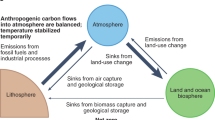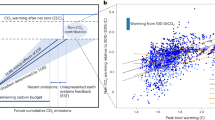Abstract
Any limit on future global warming is associated with a quota on cumulative global CO2 emissions. We translate this global carbon quota to regional and national scales, on a spectrum of sharing principles that extends from continuation of the present distribution of emissions to an equal per-capita distribution of cumulative emissions. A blend of these endpoints emerges as the most viable option. For a carbon quota consistent with a 2 °C warming limit (relative to pre-industrial levels), the necessary long-term mitigation rates are very challenging (typically over 5% per year), both because of strong limits on future emissions from the global carbon quota and also the likely short-term persistence in emissions growth in many regions.
This is a preview of subscription content, access via your institution
Access options
Subscription info for Japanese customers
We have a dedicated website for our Japanese customers. Please go to natureasia.com to subscribe to this journal.
Buy this article
- Purchase on SpringerLink
- Instant access to full article PDF
Prices may be subject to local taxes which are calculated during checkout




Similar content being viewed by others
References
Allen, M. R. et al. Warming caused by cumulative carbon emissions: towards the trillionth tonne. Nature 458, 1163–1166 (2009).
Meinshausen, M. et al. Greenhouse gas emission targets for limiting global warming to 2 °C. Nature 458, 1158–1162 (2009).
Zickfeld, K., Eby, M., Matthews, H. D. & Weaver, A. J. Setting cumulative emissions targets to reduce the risk of dangerous climate change. Proc. Natl Acad. Sci. USA 106, 16129–16134 (2009).
Matthews, H. D., Gillett, N. P., Stott, P. A. & Zickfeld, K. The proportionality of global warming to cumulative carbon emissions. Nature 459, 829–833 (2009).
Raupach, M. R. et al. The relationship between peak warming and cumulative CO2 emissions, and its use to quantify vulnerabilities in the carbon–climate–human system. Tellus B 63, 145–164 (2011).
Raupach, M. R. The exponential eigenmodes of the carbon–climate system, and their implications for ratios of responses to forcings. Earth Syst. Dynam. 4, 31–49 (2013).
European Commission The 2 °C Target: Background on Impacts, Emission Pathways, Mitigation Options and Costs (European Commission, 2008).
Collins, M. et al. in IPCC Climate Change 2013: The Physical Science Basis (eds Stocker, T. F. et al.) Ch. 12, 1029–1136 (Cambridge Univ. Press, 2013).
Matthews, H. D., Solomon, S. & Pierrehumbert, R. Cumulative carbon as a policy framework for achieving climate stabilization. Phil. Trans. R. Soc. A 370, 4365–4379 (2012).
Friedlingstein, P. et al. Persistent growth of CO2 emissions and implications for reaching climate targets. Nature Geosci. (in the press).
GEA Global Energy Assessment — Toward a Sustainable Future (Cambridge Univ. Press and International Institute for Applied Systems Analysis, 2012).
BGR Energy Study 2013: Reserves, Resources and Availability of Energy Resources (Federal Institute for Geosciences and Natural Resources, 2013).
Clarke, L. et al. in IPCC Climate Change 2014: Mitigation of Climate Change (eds Edenhofer, O. et al.) Ch. 6 (Cambridge Univ. Press, 2014).
Stavins, R. et al. in IPCC Climate Change 2014: Mitigation of Climate Change (eds Edenhofer, O. et al.) Ch. 13 (Cambridge Univ. Press, 2014).
Höhne, N., den Elzen, M. G. J. & Escalante, D. Regional GHG reduction targets based on effort sharing: a comparison of studies. Clim. Policy 14, 122–147 (2014).
Meyer, A. Contraction and Convergence. The Global Solution to Climate Change Schumacher Briefings 5 (Green Books, 2000).
Hohmeyer, O. & Rennings, K. Man-made Climate Change: Economic Aspects and Policy Considerations (ZEW Economic Studies, Centre for European Economic Research, 1999).
Bows, A. & Anderson, K. Contraction and convergence: an assessment of the CCOptions model. Climatic Change 91, 275–290 (2008).
Dellink, R. et al. Sharing the burden of financing adaptation to climate change. Glob. Environ. Change 19, 411–421 (2009).
Bartsch, U. & Mu¨ller, B. Fossil Fuels in a Changing Climate — Impacts of the Kyoto Protocol and Developing Country Participation (Oxford Univ. Press, 2000).
Füssel, H-M. How inequitable is the global distribution of responsibility, capability, and vulnerability to climate change: a comprehensive indicator-based assessment. Glob. Environ. Change 20, 597–611 (2010).
Ringius, L., Torvanger, A. & Underdal, A. Burden sharing and fairness principles in international climate policy. Int. Environ. Agreem. P. 2, 1–22 (2002).
UNFCCC Kyoto Protocol to the United Nations Framework Convention on Climate Change (United Nations Framework Convention on Climate Change, 1997).
Grasso, M. & Roberts, T. A compromise to break the climate impasse. Nature Clim. Change 4, 543–549 (2014).
European Climate Foundation Taking Stock — The Emission Levels Implied by the Pledges to the Copenhagen Accord (European Climate Foundation, 2010).
Den Elzen, M. G. J. et al. The Copenhagen Accord: abatement costs and carbon prices resulting from the submissions. Environ. Sci. Policy 14, 28–39 (2011).
Rogelj, J. et al. Analysis of the Copenhagen Accord pledges and its global climatic impacts — a snapshot of dissonant ambitions. Environ. Res. Lett. 5, 034013 (2010).
Rogelj, J. et al. Copenhagen Accord pledges are paltry. Nature 464, 1126–1128 (2010).
UNEP The Emissions Gap Report 2013 (United Nations Environment Program, 2013).
Hardin, G. The tragedy of the commons. Science 162, 1243–1248 (1968).
Kolstad, C. et al. in IPCC Climate Change 2014: Mitigation of Climate Change (eds Edenhofer, O. et al.) Ch. 3 (Cambridge Univ. Press, 2014).
Ostrom, E. Governing the Commons: The Evolution of Institutions for Collective Action (Cambridge Univ. Press, 1990).
Dietz, T., Ostrom, E. & Stern, P. C. The struggle to govern the commons. Science 302, 1907–1912 (2003).
Lejano, R. P., Araral, E. & Araral, D. Interrogating the commons: introduction to the Special Issue. Environ. Sci. Policy 36, 1–7 (2014).
Pretty, J. Social capital and the collective management of resources. Science 302, 1912–1914 (2003).
Myhre, G. et al. in IPCC Climate Change 2013: The Physical Science Basis (eds Stocker, T. F. et al.) Ch. 8, 659–740 (Cambridge Univ. Press, 2013).
Le Quéré, C. et al. Global carbon budget 2013. Earth Syst. Sci. Data 6, 235–263 (2014).
Gasser, T. & Ciais, P. A theoretical framework for the net land-to-atmosphere CO2 flux and its implications in the definition of “emissions from land-use change”. Earth Syst. Dynam. 4, 171–186 (2013).
Shindell, D. & Faluvegi, G. Climate response to regional radiative forcing during the twentieth century. Nature Geosci. 2, 294–300 (2009).
Berntsen, T. K. et al. Response of climate to regional emissions of ozone precursors: sensitivities and warming potentials. Tellus B 57, 283–304 (2005).
Trudinger, C. M. & Enting, I. G. Comparison of formalisms for attributing responsibility for climate change: non-linearities in the Brazilian proposal approach. Climatic Change 68, 67–99 (2005).
Davis, S. J., Caldeira, K. & Matthews, H. D. Future CO2 emissions and climate change from existing energy infrastructure. Science 329, 1330–1333 (2010).
Davis, S. J. & Socolow, R. H. Commitment accounting of CO2 emissions. Environ. Res. Lett. 9, 084018 (2014).
Davis, S. J., Peters, G. P. & Caldeira, K. The supply chain of CO2 emissions. Proc. Natl Acad. Sci. USA 108, 18554–18559 (2011).
van Vuuren, D. P. et al. The representative concentration pathways: an overview. Climatic Change 109, 5–31 (2011).
Kriegler, E. et al. The role of technology for achieving climate policy objectives: overview of the EMF 27 study on global technology and climate policy strategies. Climatic Change 123, 353–367 (2014).
Riahi, K. et al. Locked into Copenhagen pledges — implications of short-term 386 emission targets for the cost and feasibility of long-term climate goals. Technol. Forecast. Soc. http://dx.doi.org/10.1016/j.techfore.2013.09.016 (in the press).
Schellnhuber, H. J., Cramer, W., Nakicenovic, N., Wigley, T. M. L. & Yohe, G. Avoiding Dangerous Climate Change (Cambridge Univ. Press, 2006).
Den Elzen, M. G. J. et al. The Brazilian Proposal and Other Options for International Burden Sharing: An Evaluation of Methodological and Policy Aspects using the FAIR Model (National Institute of Public Health and the Environment, 1999).
Den Elzen, M. G. J., Schaeffer, M. & Lucas, P. L. Differentiating future commitments on the basis of countries' relative historical responsibility for climate change: uncertainties in the 'Brazilian proposal' in the context of a policy implementation. Climatic Change 71, 277–301 (2005).
Den Elzen, M. G. J., van Vuuren, D. P. & van Vliet, J. Postponing emission reductions from 2020 to 2030 increases climate risks and long-term costs. Climatic Change 99, 313–320 (2010).
Stocker, T. F. The closing door of climate targets. Science 339, 280–282 (2013).
Peters, G. P., Minx, J. C., Weber, C. L. & Edenhofer, O. Growth in emission transfers via international trade from 1990 to 2008. Proc. Natl Acad. Sci. USA 108, 8903–8908 (2011).
Andres, R. J. et al. A synthesis of carbon dioxide emissions from fossil-fuel combustion. Biogeosciences 9, 1845–1871 (2012).
Peters, G. P. & Hertwich, E. G. CO2 embodied in international trade with implications for global climate policy. Environ. Sci. Technol. 42, 1401–1407 (2008).
Hertwich, E. G. & Peters, G. P. Carbon footprint of nations: a global, trade-linked analysis. Environ. Sci. Technol. 43, 6414–6420 (2009).
Davis, S. J. & Caldeira, K. Consumption-based accounting of CO2 emissions. Proc. Natl Acad. Sci. USA 107, 5687–5692 (2010).
Peters, G. P. et al. Rapid growth in CO2 emissions after the 2008–2009 global financial crisis. Nature Clim. Change 2, 2–4 (2011).
Azar, C., Lindgren, K., Larson, E. & Mollersten, K. Carbon capture and storage from fossil fuels and biomass — costs and potential role in stabilizing the atmosphere. Climatic Change 74, 47–79 (2006).
Van Vuuren, D. P. & Riahi, K. The relationship between short-term emissions and long-term concentration targets. Climatic Change 104, 793–801 (2011).
Fuss, S. et al. Betting on negative emissions. Nature Clim. Change 4, 850–853 (2014).
Garnaut, R. Garnaut Climate Change Review: Final Report (Cambridge Univ. Press, 2008).
Garnaut, R. The Garnaut Review 2011: Australia in the Global Response to Climate Change (Cambridge Univ. Press, 2011).
Acknowledgements
M.R.R. and J.G.C. acknowledge support from the Australian Climate Change Science Program of the Department of Environment, Australian Government. G.P.P. and R.M.A. were supported by the Norwegian Research Council (236296). P.C. acknowledges support from the European Commission's 7th Framework Programme under Grant Agreements 603864 (HELIX) and the ERC Synergy Project P-IMBALANCE. P.F. was supported by the European Commission's 7th Framework Programme under Grant Agreements 282672 (EMBRACE) and 603864 (HELIX). F.J. was supported by the Australian Research Council (grant DP110102057). C.L.Q. was supported by the UK Natural Environment Research Council (NERC)'s International Opportunities Fund (project NE/103002X/1) and EU/FP7 project GEOCarbon (283080). The authors are grateful to C. Wilson and H. Ransan-Cooper for insightful comments. This work is a contribution to the Global Carbon Project (www.globalcarbonproject.org).
Author information
Authors and Affiliations
Contributions
M.R.R. designed the study, carried out calculations and coordinated the conception and writing of the paper. S.J.D. contributed data on committed emissions and drew figures. G.P.P. and R.M.A. contributed data on committed emissions and resources. All authors contributed to the writing of the paper.
Corresponding author
Ethics declarations
Competing interests
The authors declare no competing financial interests.
Supplementary information
Supplementary information
Supplementary Text and figures (PDF 1199 kb)
Rights and permissions
About this article
Cite this article
Raupach, M., Davis, S., Peters, G. et al. Sharing a quota on cumulative carbon emissions. Nature Clim Change 4, 873–879 (2014). https://doi.org/10.1038/nclimate2384
Received:
Accepted:
Published:
Issue Date:
DOI: https://doi.org/10.1038/nclimate2384



